Cross-Cultural Report: China and Japan Negotiation Style Analysis
VerifiedAdded on 2023/01/19
|6
|1282
|84
Report
AI Summary
This report provides a comparative analysis of negotiation styles between China and Japan, focusing on cultural differences and their impact on business interactions. It begins by justifying the choice of these two countries, highlighting their significant economic ties and contrasting cultural traditions. The report then identifies key cultural differences, such as approaches to silence and decision-making, and links these to relevant theoretical frameworks, particularly the Hofstede model. It examines cultural dimensions like power distance, individualism versus collectivism, and long-term orientation, demonstrating how these influence negotiation strategies. The report also delves into specific negotiation behaviors, such as the Chinese emphasis on home-field advantage and the Japanese preference for consensus-building. Finally, it identifies potential management issues that may arise when members from both cultures collaborate, suggesting strategies for managing these challenges, such as adapting negotiation locations and timelines to accommodate cultural preferences.
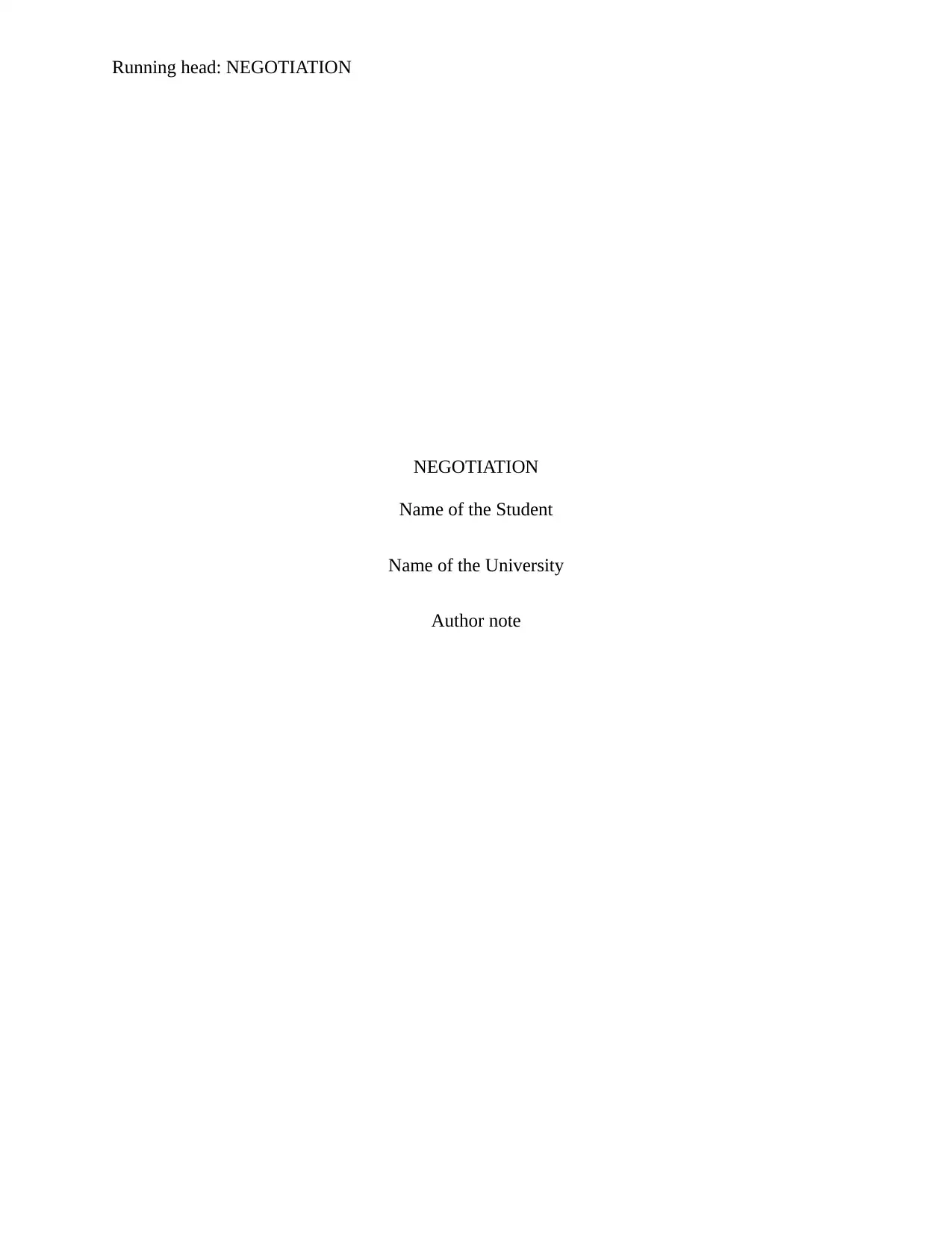
Running head: NEGOTIATION
NEGOTIATION
Name of the Student
Name of the University
Author note
NEGOTIATION
Name of the Student
Name of the University
Author note
Paraphrase This Document
Need a fresh take? Get an instant paraphrase of this document with our AI Paraphraser
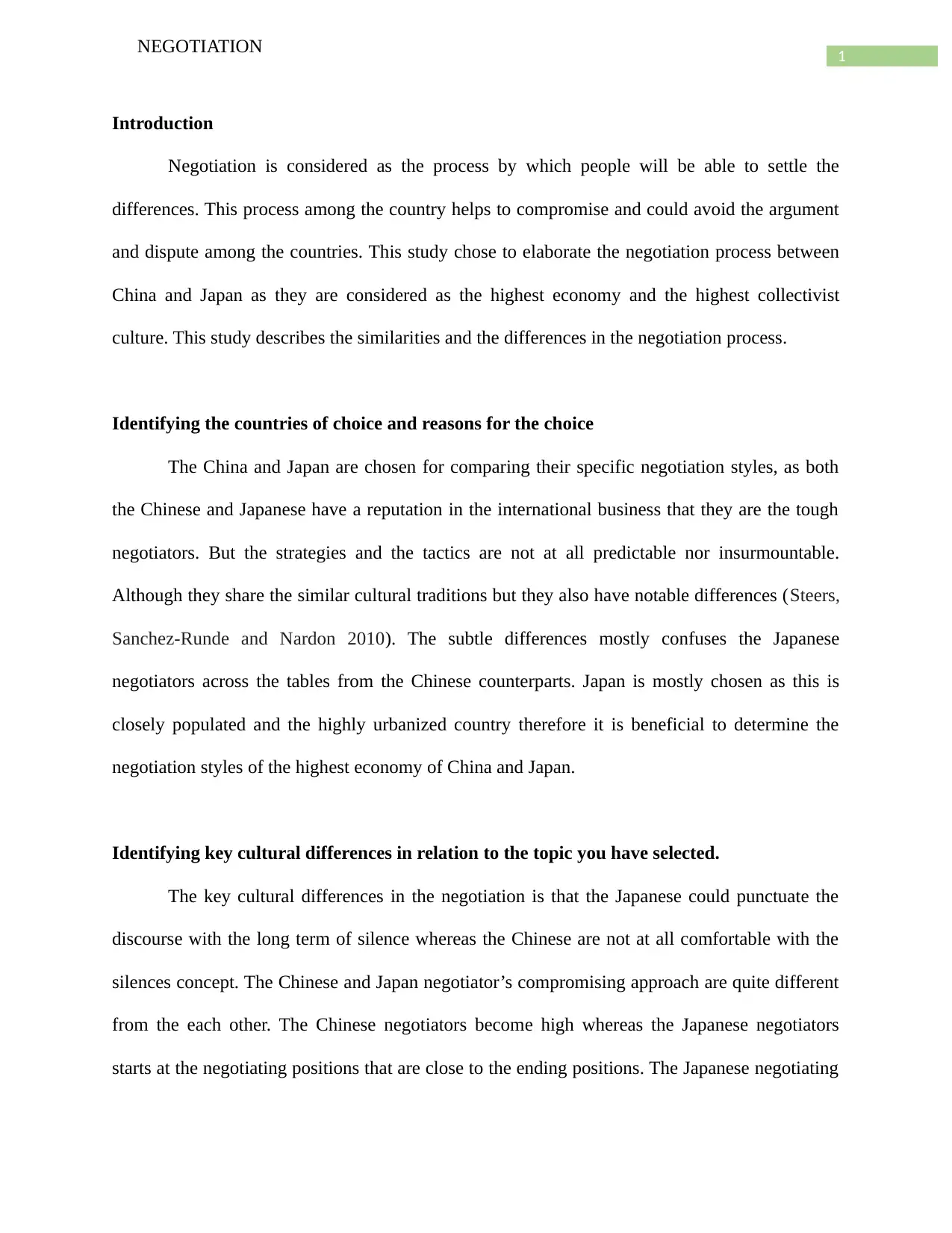
1
NEGOTIATION
Introduction
Negotiation is considered as the process by which people will be able to settle the
differences. This process among the country helps to compromise and could avoid the argument
and dispute among the countries. This study chose to elaborate the negotiation process between
China and Japan as they are considered as the highest economy and the highest collectivist
culture. This study describes the similarities and the differences in the negotiation process.
Identifying the countries of choice and reasons for the choice
The China and Japan are chosen for comparing their specific negotiation styles, as both
the Chinese and Japanese have a reputation in the international business that they are the tough
negotiators. But the strategies and the tactics are not at all predictable nor insurmountable.
Although they share the similar cultural traditions but they also have notable differences (Steers,
Sanchez-Runde and Nardon 2010). The subtle differences mostly confuses the Japanese
negotiators across the tables from the Chinese counterparts. Japan is mostly chosen as this is
closely populated and the highly urbanized country therefore it is beneficial to determine the
negotiation styles of the highest economy of China and Japan.
Identifying key cultural differences in relation to the topic you have selected.
The key cultural differences in the negotiation is that the Japanese could punctuate the
discourse with the long term of silence whereas the Chinese are not at all comfortable with the
silences concept. The Chinese and Japan negotiator’s compromising approach are quite different
from the each other. The Chinese negotiators become high whereas the Japanese negotiators
starts at the negotiating positions that are close to the ending positions. The Japanese negotiating
NEGOTIATION
Introduction
Negotiation is considered as the process by which people will be able to settle the
differences. This process among the country helps to compromise and could avoid the argument
and dispute among the countries. This study chose to elaborate the negotiation process between
China and Japan as they are considered as the highest economy and the highest collectivist
culture. This study describes the similarities and the differences in the negotiation process.
Identifying the countries of choice and reasons for the choice
The China and Japan are chosen for comparing their specific negotiation styles, as both
the Chinese and Japanese have a reputation in the international business that they are the tough
negotiators. But the strategies and the tactics are not at all predictable nor insurmountable.
Although they share the similar cultural traditions but they also have notable differences (Steers,
Sanchez-Runde and Nardon 2010). The subtle differences mostly confuses the Japanese
negotiators across the tables from the Chinese counterparts. Japan is mostly chosen as this is
closely populated and the highly urbanized country therefore it is beneficial to determine the
negotiation styles of the highest economy of China and Japan.
Identifying key cultural differences in relation to the topic you have selected.
The key cultural differences in the negotiation is that the Japanese could punctuate the
discourse with the long term of silence whereas the Chinese are not at all comfortable with the
silences concept. The Chinese and Japan negotiator’s compromising approach are quite different
from the each other. The Chinese negotiators become high whereas the Japanese negotiators
starts at the negotiating positions that are close to the ending positions. The Japanese negotiating
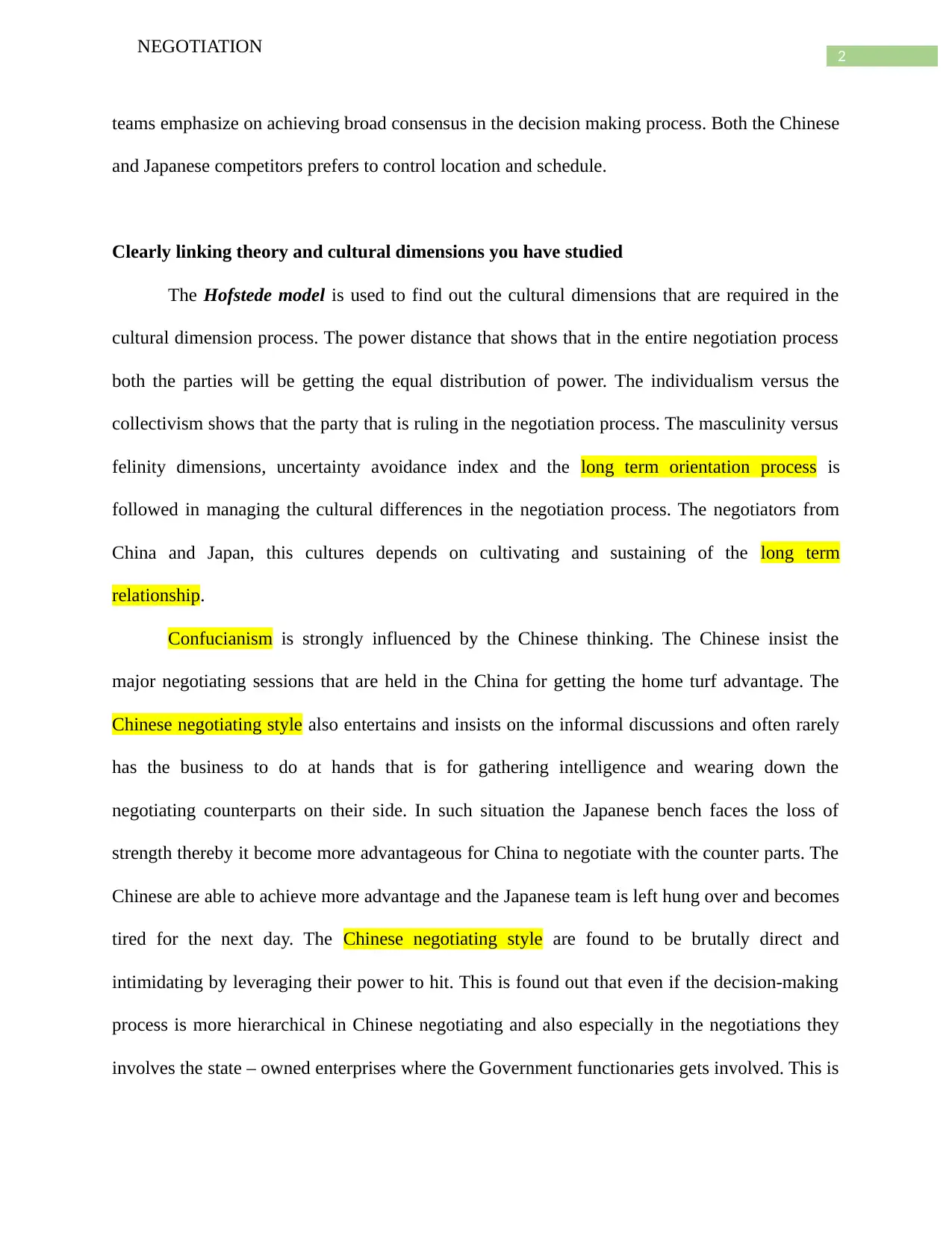
2
NEGOTIATION
teams emphasize on achieving broad consensus in the decision making process. Both the Chinese
and Japanese competitors prefers to control location and schedule.
Clearly linking theory and cultural dimensions you have studied
The Hofstede model is used to find out the cultural dimensions that are required in the
cultural dimension process. The power distance that shows that in the entire negotiation process
both the parties will be getting the equal distribution of power. The individualism versus the
collectivism shows that the party that is ruling in the negotiation process. The masculinity versus
felinity dimensions, uncertainty avoidance index and the long term orientation process is
followed in managing the cultural differences in the negotiation process. The negotiators from
China and Japan, this cultures depends on cultivating and sustaining of the long term
relationship.
Confucianism is strongly influenced by the Chinese thinking. The Chinese insist the
major negotiating sessions that are held in the China for getting the home turf advantage. The
Chinese negotiating style also entertains and insists on the informal discussions and often rarely
has the business to do at hands that is for gathering intelligence and wearing down the
negotiating counterparts on their side. In such situation the Japanese bench faces the loss of
strength thereby it become more advantageous for China to negotiate with the counter parts. The
Chinese are able to achieve more advantage and the Japanese team is left hung over and becomes
tired for the next day. The Chinese negotiating style are found to be brutally direct and
intimidating by leveraging their power to hit. This is found out that even if the decision-making
process is more hierarchical in Chinese negotiating and also especially in the negotiations they
involves the state – owned enterprises where the Government functionaries gets involved. This is
NEGOTIATION
teams emphasize on achieving broad consensus in the decision making process. Both the Chinese
and Japanese competitors prefers to control location and schedule.
Clearly linking theory and cultural dimensions you have studied
The Hofstede model is used to find out the cultural dimensions that are required in the
cultural dimension process. The power distance that shows that in the entire negotiation process
both the parties will be getting the equal distribution of power. The individualism versus the
collectivism shows that the party that is ruling in the negotiation process. The masculinity versus
felinity dimensions, uncertainty avoidance index and the long term orientation process is
followed in managing the cultural differences in the negotiation process. The negotiators from
China and Japan, this cultures depends on cultivating and sustaining of the long term
relationship.
Confucianism is strongly influenced by the Chinese thinking. The Chinese insist the
major negotiating sessions that are held in the China for getting the home turf advantage. The
Chinese negotiating style also entertains and insists on the informal discussions and often rarely
has the business to do at hands that is for gathering intelligence and wearing down the
negotiating counterparts on their side. In such situation the Japanese bench faces the loss of
strength thereby it become more advantageous for China to negotiate with the counter parts. The
Chinese are able to achieve more advantage and the Japanese team is left hung over and becomes
tired for the next day. The Chinese negotiating style are found to be brutally direct and
intimidating by leveraging their power to hit. This is found out that even if the decision-making
process is more hierarchical in Chinese negotiating and also especially in the negotiations they
involves the state – owned enterprises where the Government functionaries gets involved. This is
⊘ This is a preview!⊘
Do you want full access?
Subscribe today to unlock all pages.

Trusted by 1+ million students worldwide
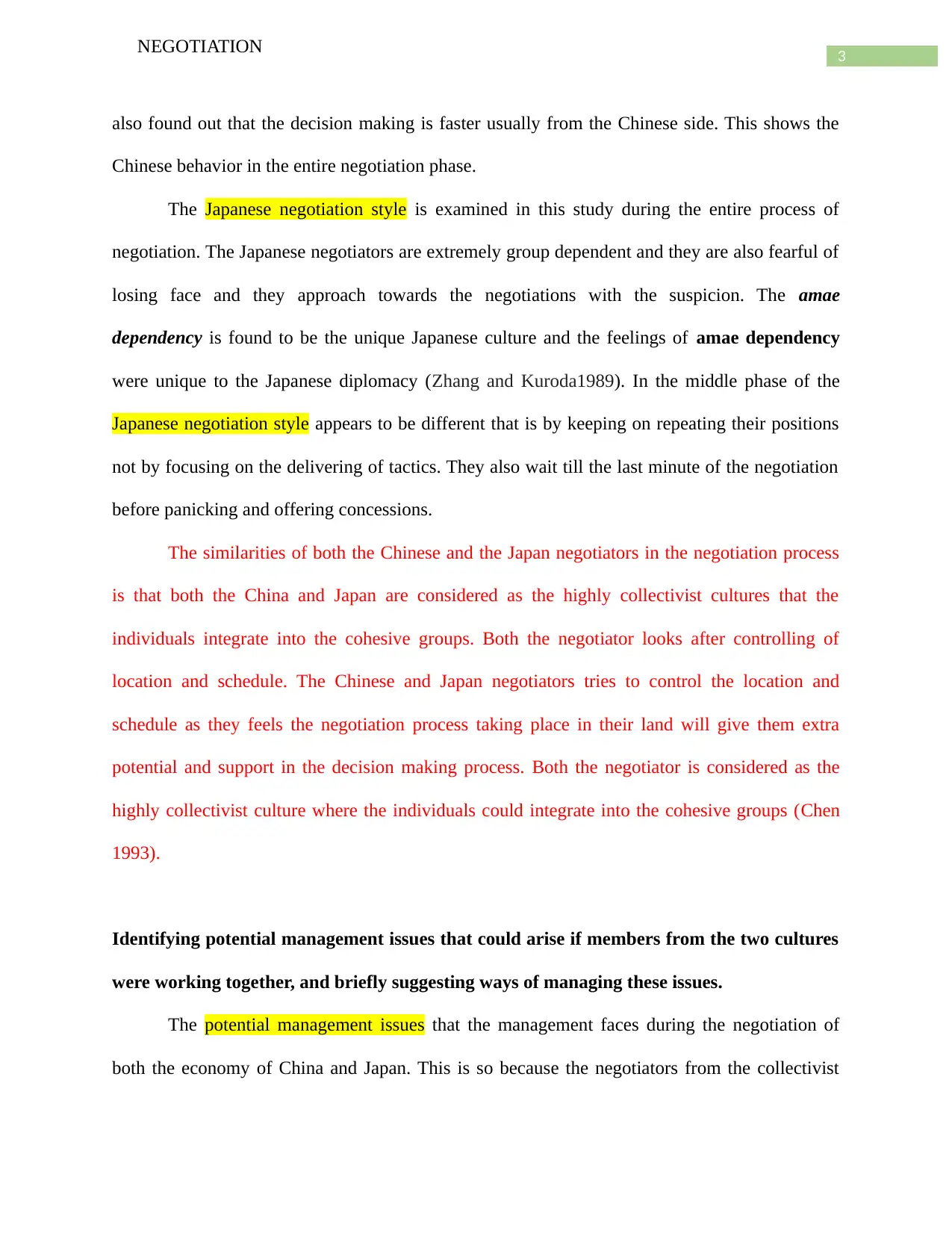
3
NEGOTIATION
also found out that the decision making is faster usually from the Chinese side. This shows the
Chinese behavior in the entire negotiation phase.
The Japanese negotiation style is examined in this study during the entire process of
negotiation. The Japanese negotiators are extremely group dependent and they are also fearful of
losing face and they approach towards the negotiations with the suspicion. The amae
dependency is found to be the unique Japanese culture and the feelings of amae dependency
were unique to the Japanese diplomacy (Zhang and Kuroda1989). In the middle phase of the
Japanese negotiation style appears to be different that is by keeping on repeating their positions
not by focusing on the delivering of tactics. They also wait till the last minute of the negotiation
before panicking and offering concessions.
The similarities of both the Chinese and the Japan negotiators in the negotiation process
is that both the China and Japan are considered as the highly collectivist cultures that the
individuals integrate into the cohesive groups. Both the negotiator looks after controlling of
location and schedule. The Chinese and Japan negotiators tries to control the location and
schedule as they feels the negotiation process taking place in their land will give them extra
potential and support in the decision making process. Both the negotiator is considered as the
highly collectivist culture where the individuals could integrate into the cohesive groups (Chen
1993).
Identifying potential management issues that could arise if members from the two cultures
were working together, and briefly suggesting ways of managing these issues.
The potential management issues that the management faces during the negotiation of
both the economy of China and Japan. This is so because the negotiators from the collectivist
NEGOTIATION
also found out that the decision making is faster usually from the Chinese side. This shows the
Chinese behavior in the entire negotiation phase.
The Japanese negotiation style is examined in this study during the entire process of
negotiation. The Japanese negotiators are extremely group dependent and they are also fearful of
losing face and they approach towards the negotiations with the suspicion. The amae
dependency is found to be the unique Japanese culture and the feelings of amae dependency
were unique to the Japanese diplomacy (Zhang and Kuroda1989). In the middle phase of the
Japanese negotiation style appears to be different that is by keeping on repeating their positions
not by focusing on the delivering of tactics. They also wait till the last minute of the negotiation
before panicking and offering concessions.
The similarities of both the Chinese and the Japan negotiators in the negotiation process
is that both the China and Japan are considered as the highly collectivist cultures that the
individuals integrate into the cohesive groups. Both the negotiator looks after controlling of
location and schedule. The Chinese and Japan negotiators tries to control the location and
schedule as they feels the negotiation process taking place in their land will give them extra
potential and support in the decision making process. Both the negotiator is considered as the
highly collectivist culture where the individuals could integrate into the cohesive groups (Chen
1993).
Identifying potential management issues that could arise if members from the two cultures
were working together, and briefly suggesting ways of managing these issues.
The potential management issues that the management faces during the negotiation of
both the economy of China and Japan. This is so because the negotiators from the collectivist
Paraphrase This Document
Need a fresh take? Get an instant paraphrase of this document with our AI Paraphraser
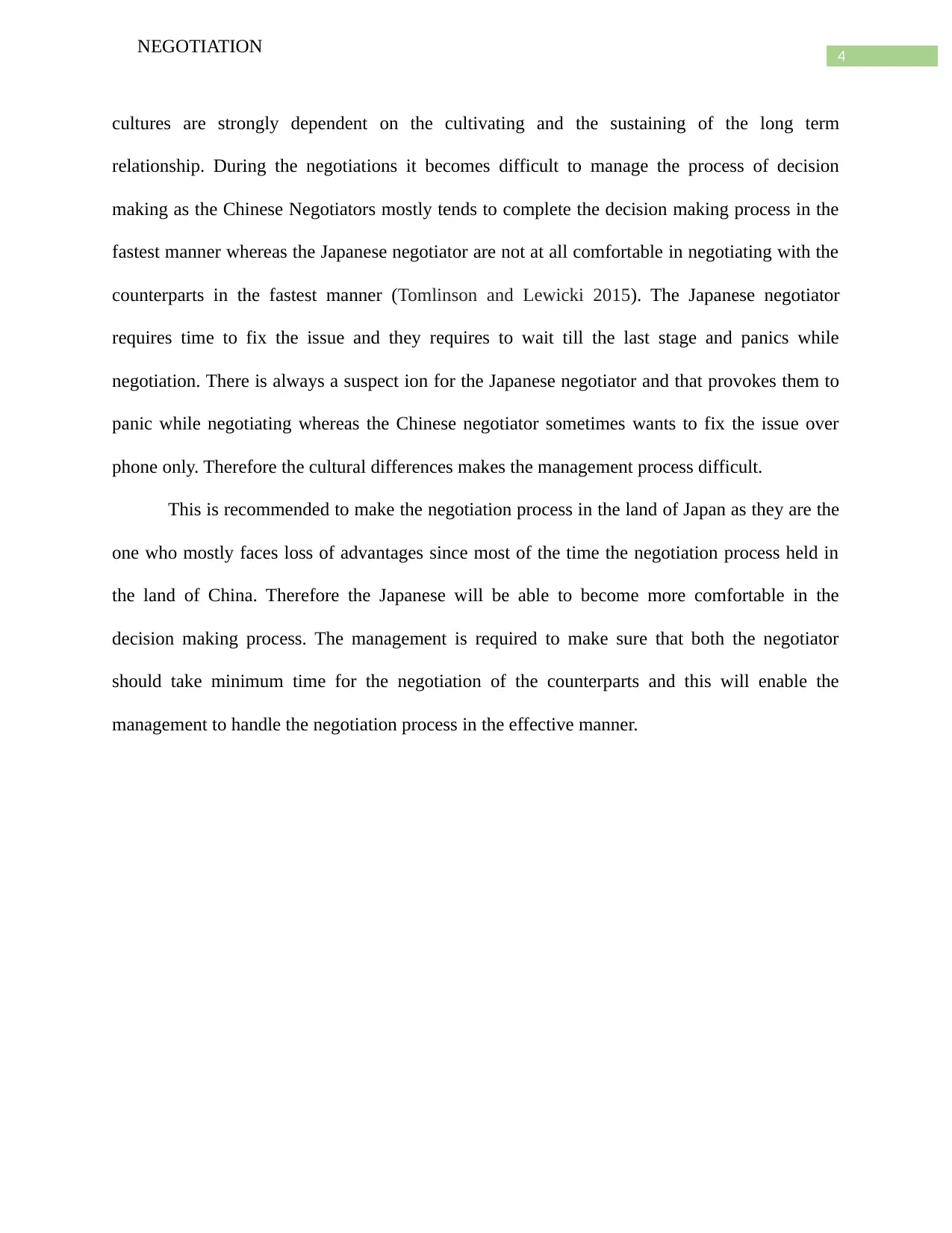
4
NEGOTIATION
cultures are strongly dependent on the cultivating and the sustaining of the long term
relationship. During the negotiations it becomes difficult to manage the process of decision
making as the Chinese Negotiators mostly tends to complete the decision making process in the
fastest manner whereas the Japanese negotiator are not at all comfortable in negotiating with the
counterparts in the fastest manner (Tomlinson and Lewicki 2015). The Japanese negotiator
requires time to fix the issue and they requires to wait till the last stage and panics while
negotiation. There is always a suspect ion for the Japanese negotiator and that provokes them to
panic while negotiating whereas the Chinese negotiator sometimes wants to fix the issue over
phone only. Therefore the cultural differences makes the management process difficult.
This is recommended to make the negotiation process in the land of Japan as they are the
one who mostly faces loss of advantages since most of the time the negotiation process held in
the land of China. Therefore the Japanese will be able to become more comfortable in the
decision making process. The management is required to make sure that both the negotiator
should take minimum time for the negotiation of the counterparts and this will enable the
management to handle the negotiation process in the effective manner.
NEGOTIATION
cultures are strongly dependent on the cultivating and the sustaining of the long term
relationship. During the negotiations it becomes difficult to manage the process of decision
making as the Chinese Negotiators mostly tends to complete the decision making process in the
fastest manner whereas the Japanese negotiator are not at all comfortable in negotiating with the
counterparts in the fastest manner (Tomlinson and Lewicki 2015). The Japanese negotiator
requires time to fix the issue and they requires to wait till the last stage and panics while
negotiation. There is always a suspect ion for the Japanese negotiator and that provokes them to
panic while negotiating whereas the Chinese negotiator sometimes wants to fix the issue over
phone only. Therefore the cultural differences makes the management process difficult.
This is recommended to make the negotiation process in the land of Japan as they are the
one who mostly faces loss of advantages since most of the time the negotiation process held in
the land of China. Therefore the Japanese will be able to become more comfortable in the
decision making process. The management is required to make sure that both the negotiator
should take minimum time for the negotiation of the counterparts and this will enable the
management to handle the negotiation process in the effective manner.
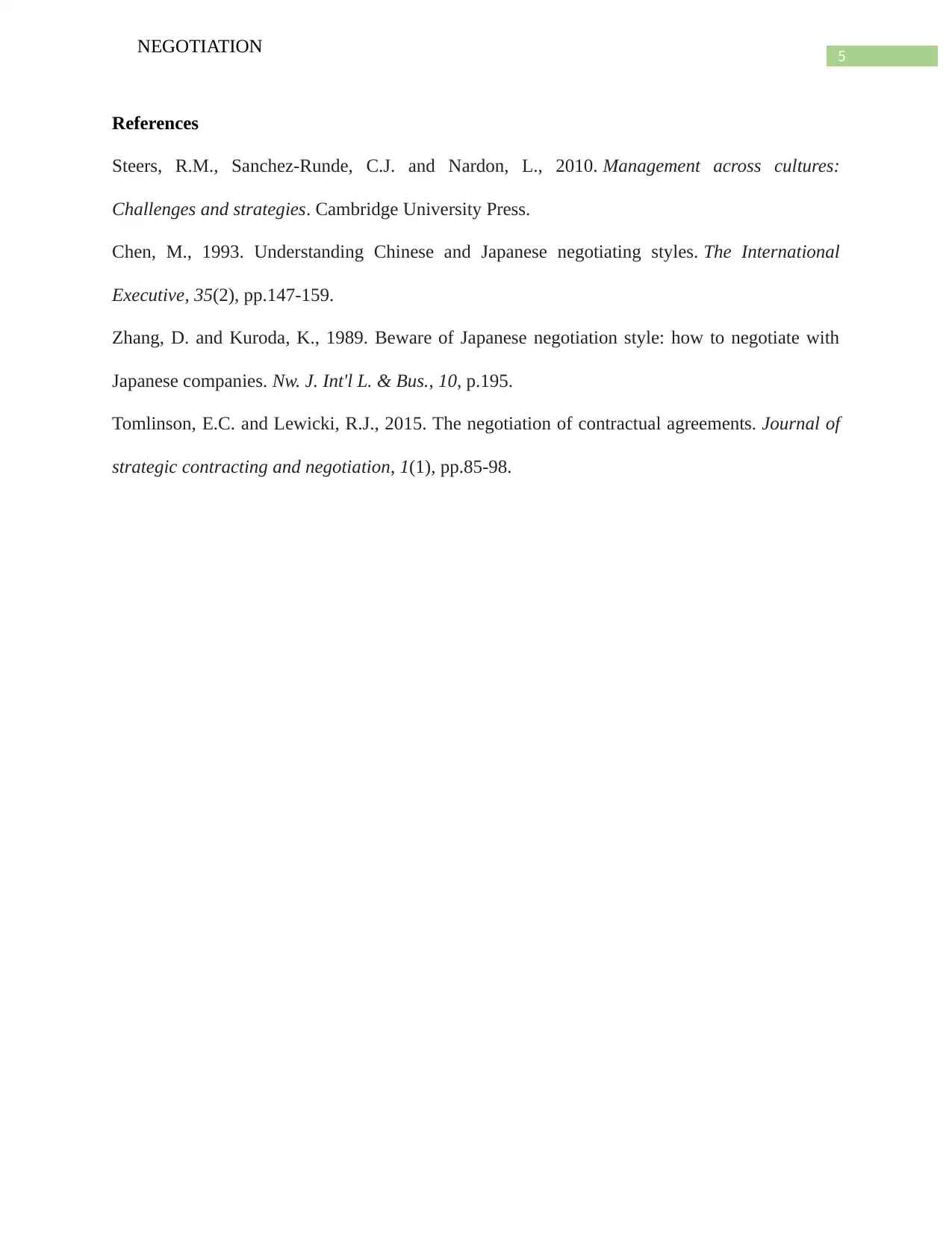
5
NEGOTIATION
References
Steers, R.M., Sanchez-Runde, C.J. and Nardon, L., 2010. Management across cultures:
Challenges and strategies. Cambridge University Press.
Chen, M., 1993. Understanding Chinese and Japanese negotiating styles. The International
Executive, 35(2), pp.147-159.
Zhang, D. and Kuroda, K., 1989. Beware of Japanese negotiation style: how to negotiate with
Japanese companies. Nw. J. Int'l L. & Bus., 10, p.195.
Tomlinson, E.C. and Lewicki, R.J., 2015. The negotiation of contractual agreements. Journal of
strategic contracting and negotiation, 1(1), pp.85-98.
NEGOTIATION
References
Steers, R.M., Sanchez-Runde, C.J. and Nardon, L., 2010. Management across cultures:
Challenges and strategies. Cambridge University Press.
Chen, M., 1993. Understanding Chinese and Japanese negotiating styles. The International
Executive, 35(2), pp.147-159.
Zhang, D. and Kuroda, K., 1989. Beware of Japanese negotiation style: how to negotiate with
Japanese companies. Nw. J. Int'l L. & Bus., 10, p.195.
Tomlinson, E.C. and Lewicki, R.J., 2015. The negotiation of contractual agreements. Journal of
strategic contracting and negotiation, 1(1), pp.85-98.
⊘ This is a preview!⊘
Do you want full access?
Subscribe today to unlock all pages.

Trusted by 1+ million students worldwide
1 out of 6
Your All-in-One AI-Powered Toolkit for Academic Success.
+13062052269
info@desklib.com
Available 24*7 on WhatsApp / Email
![[object Object]](/_next/static/media/star-bottom.7253800d.svg)
Unlock your academic potential
Copyright © 2020–2025 A2Z Services. All Rights Reserved. Developed and managed by ZUCOL.

